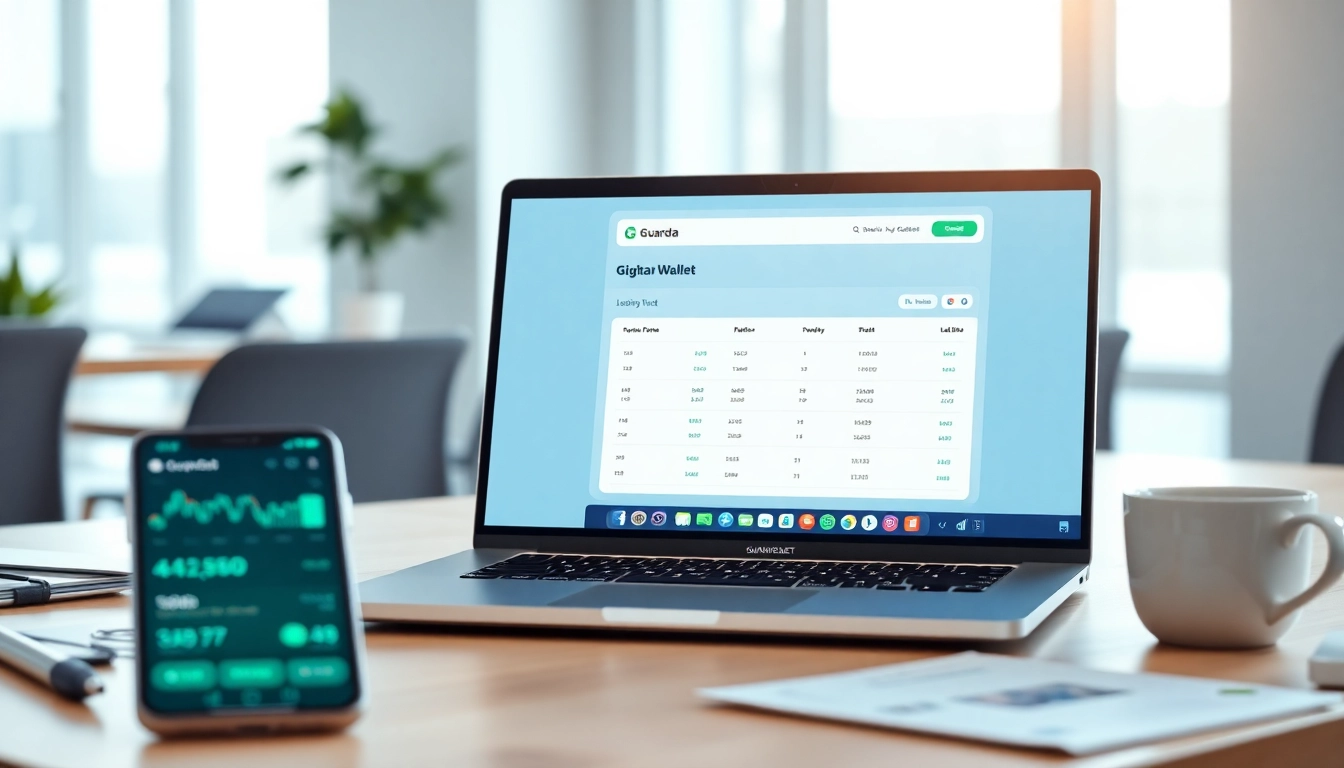Understanding the Exodus Wallet: A Brief Overview
What is the Exodus Wallet?
The exodus wallet is a well-known cryptocurrency software wallet designed for both beginner and advanced users. Launched in 2016 by Exodus Movement, Inc., this wallet serves as a multi-currency platform that supports over 100 cryptocurrencies including Bitcoin, Ethereum, and Litecoin, among many others. Its user-friendly interface allows users to effortlessly manage digital assets, making it an appealing option for individuals looking to explore the world of cryptocurrencies.
Exodus is primarily known for its desktop and mobile applications, which synchronize seamlessly across devices. This versatility allows users to engage with their crypto holdings from anywhere while ensuring quick access to essential functionalities, such as sending, receiving, and exchanging cryptocurrencies. As one of the most popular choices in the crypto community, it has continually evolved to incorporate advanced features and enhance user experience.
Key Features of the Exodus Wallet
Exodus Wallet is packed with several features that make it stand out among its competitors:
- User-Friendly Interface: The wallet’s design is intuitive, allowing users, regardless of their experience level, to navigate easily through its various features.
- Multi-Currency Support: With more than 100 supported cryptocurrencies, users can easily manage diverse portfolios all in one place.
- In-Built Exchange: Exodus provides a built-in exchange for users to swap cryptocurrencies effortlessly without the need to transfer funds to external exchanges.
- Portfolio Tracking: Users can view their asset distribution and transaction history, helping them keep an eye on their investments effectively.
- Security Features: Exodus includes features like an easy backup and recovery process, ensuring users’ funds remain safe.
- Staking Options: Users can earn passive income by staking supported cryptocurrencies directly within the wallet.
The Security of Exodus Wallet Explained
Security is a top priority for cryptocurrency users, and Exodus Wallet doesn’t disappoint. The wallet is non-custodial, which means that users maintain full control over their private keys. Exodus is designed to store these keys locally, safeguarding users from potential server breaches associated with custodial wallets.
In addition to private key control, Exodus employs industry-standard security best practices:
- Encryption: Private keys and transaction data are encrypted on the device, ensuring no third-party can access them.
- Backup Features: Users can easily create backups of the wallet, ensuring recovery options are available should they lose access to their device.
- Regular Updates: The Exodus team frequently updates the wallet to address any vulnerabilities and improve functionality, ensuring a high level of security.
Setting Up Your Exodus Wallet: A Step-by-Step Guide
Creating Your Account on Exodus Wallet
Setting up an Exodus Wallet is a straightforward process:
- Download the Wallet: Visit the official Exodus website to download the wallet for either desktop or mobile. Ensure that you are downloading from the official source to avoid malware.
- Install and Open the App: Follow the installation instructions and then open the app to begin the setup process.
- Create a New Wallet: Select “Create a New Wallet” option. You will be guided through the process, where the wallet will generate an automatically created recovery phrase.
- Backup Your Recovery Phrase: Write down your recovery phrase and store it in a secure location. This phrase is crucial for restoring access to your wallet.
- Finish Setup: After entering your recovery phrase, you can set up a password for your wallet, ensuring an additional layer of security.
Connecting Exodus Wallet to Your Devices
Exodus allows you to access your wallet from multiple devices, including desktop and mobile:
- Desktop Access: Install the wallet on your computer, log in using your password, and access your funds immediately.
- Mobile Access: Download the mobile app on your iOS or Android device. You can log in with the same password you use on the desktop.
Configuring Security Settings in Your Exodus Wallet
Securing your Exodus Wallet is vital for protecting your assets. Here’s how to configure your security settings:
- Set a Strong Password: Always create a strong, unique password that combines letters, numbers, and special characters.
- Enable Backups: Regularly back up your wallet to ensure you can recover your funds if needed. Use the recovery phrase in conjunction with the wallet passwords.
- Consider Hardware Wallet Integration: Utilize hardware wallets such as Trezor or Ledger alongside Exodus for added security during crypto management and storage.
Using Exodus Wallet for Transactions
How to Send and Receive Cryptocurrency on Exodus Wallet
Exodus Wallet facilitates easy transactions. Here’s how to send and receive cryptocurrencies:
Sending Cryptocurrency
- Open your Exodus Wallet and select the cryptocurrency you wish to send.
- Select “Send” and input the recipient’s wallet address. Ensure you double-check the address to avoid errors.
- Specify the amount you want to send and review the fee estimates before confirming the transaction.
- Click “Send.” You will receive notifications upon successful transactions.
Receiving Cryptocurrency
- Go to the “Receive” section in your wallet.
- Select the cryptocurrency you wish to receive.
- Share your wallet address with the sender. You can also scan the QR code provided for easy access.
- Monitor your wallet to confirm that the funds have arrived.
Exchange and Swap Features in Exodus Wallet
The convenience of exchanging cryptocurrencies without moving assets to external exchanges is one of Exodus Wallet’s strongest attributes. Users can:
- Trade Directly: Use the built-in exchange feature to trade one cryptocurrency for another quickly.
- Monitor Exchange Rates: The wallet displays current exchange rates, helping users make informed decisions.
- Transaction Fees: Understand the fees associated with the exchange process as they may vary depending on market conditions and trades.
Tracking Your Portfolio with the Exodus Wallet
Exodus Wallet provides a comprehensive view of your cryptocurrency investments:
- Portfolio Overview: The home screen displays an overview of your holdings, making it easy to track your investments at a glance.
- Track Portfolio Growth: Users can see how their investments perform over time, allowing for better financial planning.
- Exporting Data: For those who want to maintain reports or tax filings, the wallet allows users to export transaction history in various formats.
Advanced Features of the Exodus Wallet
Exploring Exodus Wallet’s Built-in Exchange Options
Besides the primary transaction functions, Exodus provides advanced exchange options:
- Instant Swaps: The wallet enables users to swap crypto assets without lengthy processing times.
- Partner Integrations: Exodus partners with various exchange platforms, facilitating seamless transactions while retaining ease of use.
- Dynamic Rates: The wallet frequently updates rates to ensure users get competitive pricing for their trades.
Utilizing Exodus Wallet for Staking Cryptocurrencies
Staking is a popular method for earning rewards on held cryptocurrencies. Exodus Wallet allows users to:
- Stake Directly: Users can stake supported cryptocurrencies right within the wallet interface, which simplifies income generation from idle assets.
- Track Earnings: The wallet tracks and displays estimated rewards based on the amount and duration of staking.
- Learn About Staking: Exodus provides educational resources about how different cryptocurrencies work in terms of staking; users can learn about potential rewards and risks.
Integrating Exodus Wallet with Hardware Wallets
For those seeking enhanced security, combining Exodus with hardware wallets is a great option. Here’s how to integrate:
- Enhanced Security: Hardware wallets like Trezor or Ledger can store your private keys offline, significantly reducing vulnerability to hackers.
- Seamless Access: Users can connect their hardware wallets to Exodus, enabling easy management of funds while leveraging the security hardware wallets provide.
- Guided Integration: Exodus offers detailed guides for setting up and integrating hardware wallets with their software wallet functionalities.
Common Issues and Troubleshooting for Exodus Wallet Users
Addressing Security Concerns with Exodus Wallet
While Exodus Wallet is designed with security in mind, users should remain vigilant against common issues:
- Recovering from a Phishing Attack: If a phishing attempt occurs, do not provide personal information and report the incident immediately.
- Private Key Protection: Always ensure your private keys remain private and are not shared or stored publicly.
- Two-Factor Authentication: Though Exodus doesn’t currently support 2FA, users can increase their security with strong passwords and regular backups.
Resolving Technical Issues in Exodus Wallet
Users may occasionally encounter technical difficulties, but many issues can be resolved quickly:
- Transaction Delays: If transactions are slow, check the current network status of the cryptocurrency being transacted, as congestion can delay processing.
- Login Problems: If encountering login issues, ensure you are using the correct password and recovery phrase. Contact customer support for recovery.
- Software Updates: Regularly update the wallet to the latest version, which may address bugs and improve functionality.
Tips for Maintaining Your Exodus Wallet Effectively
Maintaining your Exodus Wallet properly can prevent future issues:
- Regular Backups: Set a schedule to ensure timely backups of your wallet data.
- Stay Informed: Follow news and updates from Exodus to stay aware of potential vulnerabilities and security patches.
- Use Strong Passwords: Regularly change your password and utilize password manager tools to keep your passwords secure and accessible.



